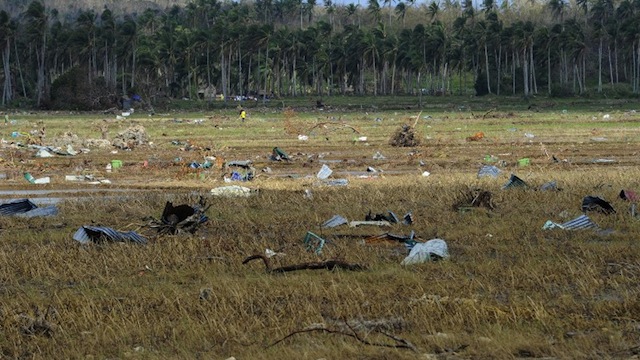SUMMARY
This is AI generated summarization, which may have errors. For context, always refer to the full article.

MANILA, Philippines – The Philippines will not be self-sufficient in rice this year, the government admits, as assessed damage from Typhoon Yolanda (Haiyan) continues to grow.
The Agriculture department said massive damage wrought by Yolanda on the agriculture sector will prevent the country from attaining its rice production goals for 2013.
On Thursday, Yolanda’s damage to agriculture rose to P9.73 billion, with the rice sub-sector incurring the most damage.
The super typhoon destroyed rice lands in Regions VI, VII, and VIII, prompting DA to drop this year’s self-sufficiency target.
DA said palay production is expected to post flat growth in 2013 from last year. It will be sufficient to cover domestic requirements but will fall short of the required 90-day buffer stock.
Agriculture Undersecretary Dante Delima, also National Rice Program Coordinator, said that by yearend, the Philippines will be able to achieve 95% to 97% rice self-sufficiency, with production seen reaching 18.03 million metric tons (MT), the same as last year’s level.
“We can meet the domestic requirement with this level of production, but we can only attain a 50-day buffer stock,” he said.
To be 100% self-sufficient in rice, the country needs to be able to provide for 90-day buffer.
Before Yolanda struck, DA was eyeing a production of 19 million to 20 million MT for 2013.
Imports
Yolanda destroyed 143,774 MT of palay planted in 77,476 hectares of land. Of this, 36,038 hectares may still recover. Production loss was placed at P2.33 billion.
The National Food Authority (NFA) has approved the importation of 500,000 MT of rice under a
government-to-government tender before the end of the year to increase the country’s buffer stock by at least 14 days.
The rice may be sourced from Thailand, Cambodia or Vietnam, with whom the Philippines already has procurement agreements.
Delima asked the NFA to bring in by December the first 300,000 MT to support relief operations in Visayas.
He said the ongoing harvest in unaffected areas will still contribute to the buffer stock.
Delima said that before the onslaught of Yolanda, the Philippines had a buffer stock good for at least 85 days.
Damage to other crops
The government is still surveying the extent of damage to farm lands.
On Thursday, production losses in the corn sector reached P284.65 million, equivalent to 22,119 MT of produce planted in 20,951 hectares.
The coconut sub-sector sustained P1.52 billion worth of damage as Yolanda eradicated in one fell swoop 41,662 hectares of coconut plantations.
(READ: Coconut farmers face ruin after Haiyan)
Substantial damage was also seen in livestock and fisheries, with production losses amounting to P2.32 billion and P1.06, respectively.
The cost of damage to irrigation and farm infrastructure has climbed to P1.63 billion. – Rappler.com
Add a comment
How does this make you feel?
There are no comments yet. Add your comment to start the conversation.